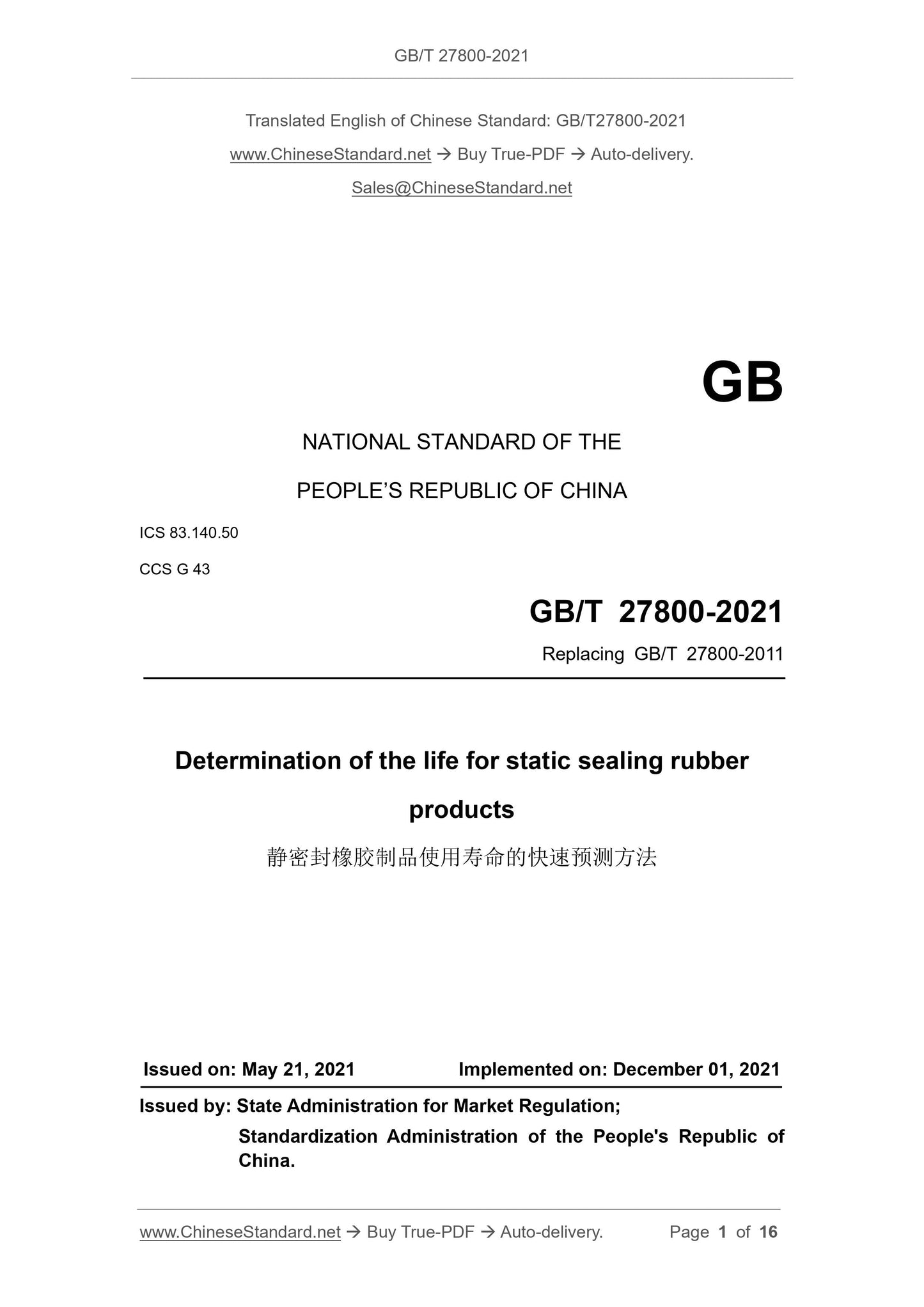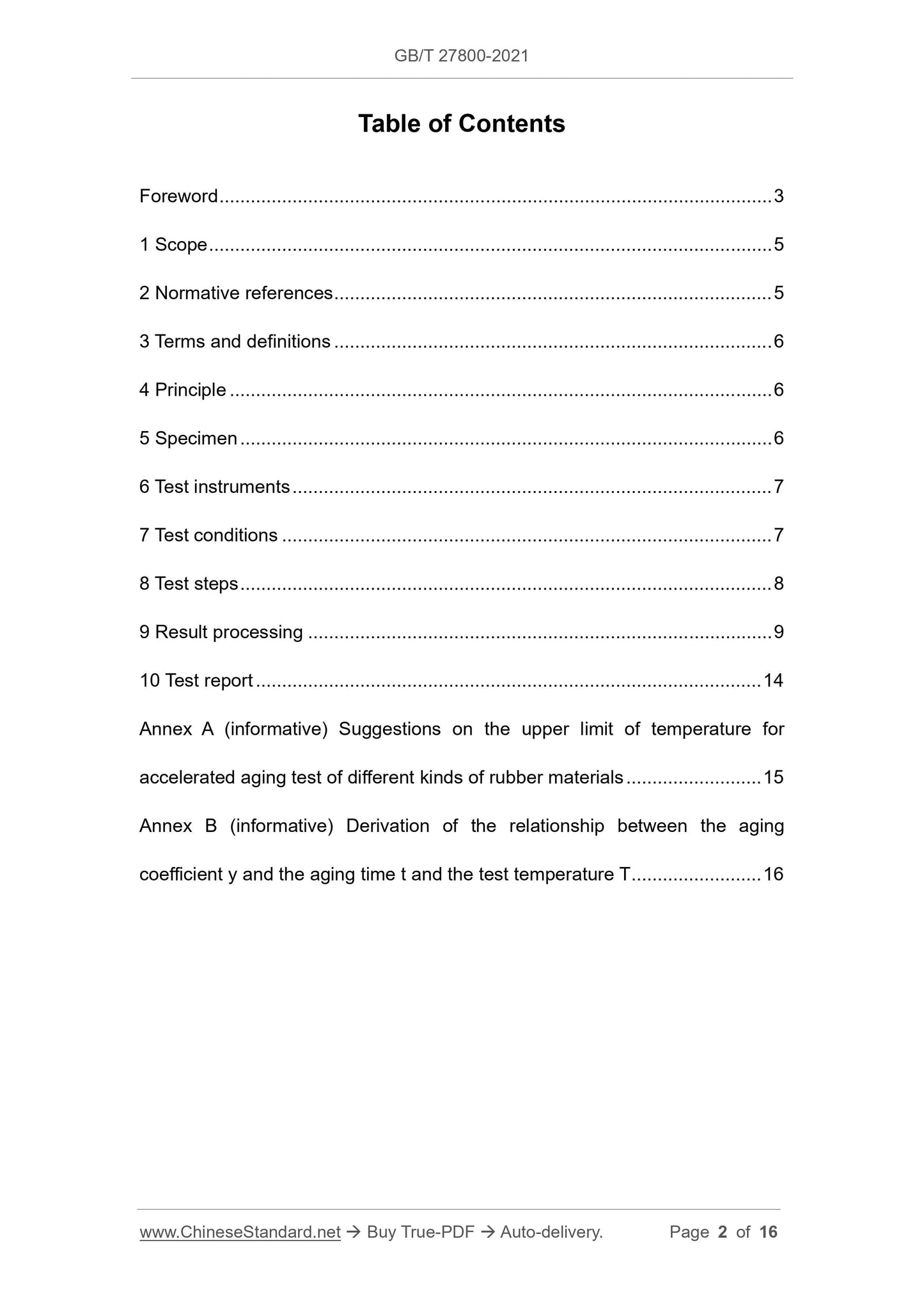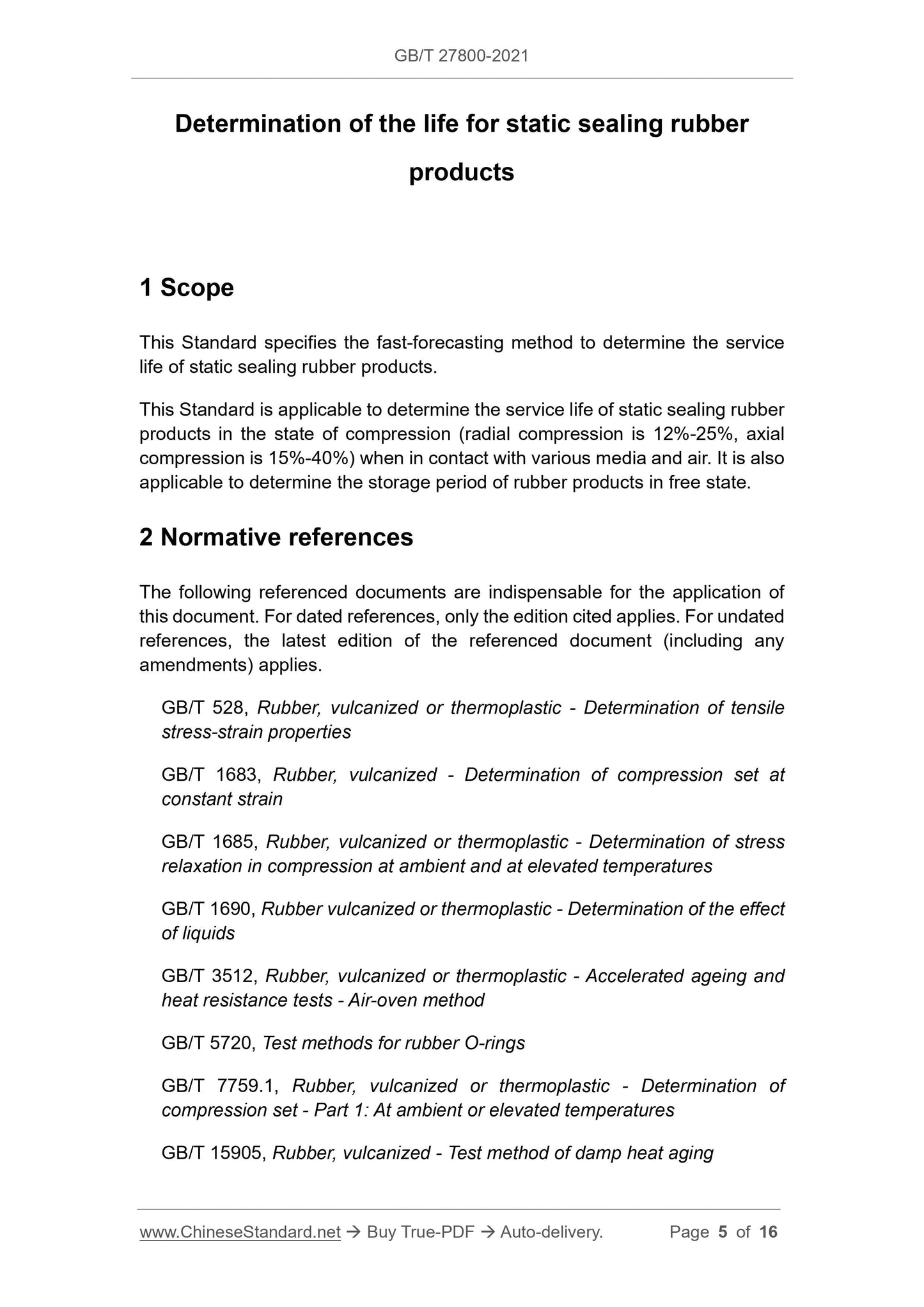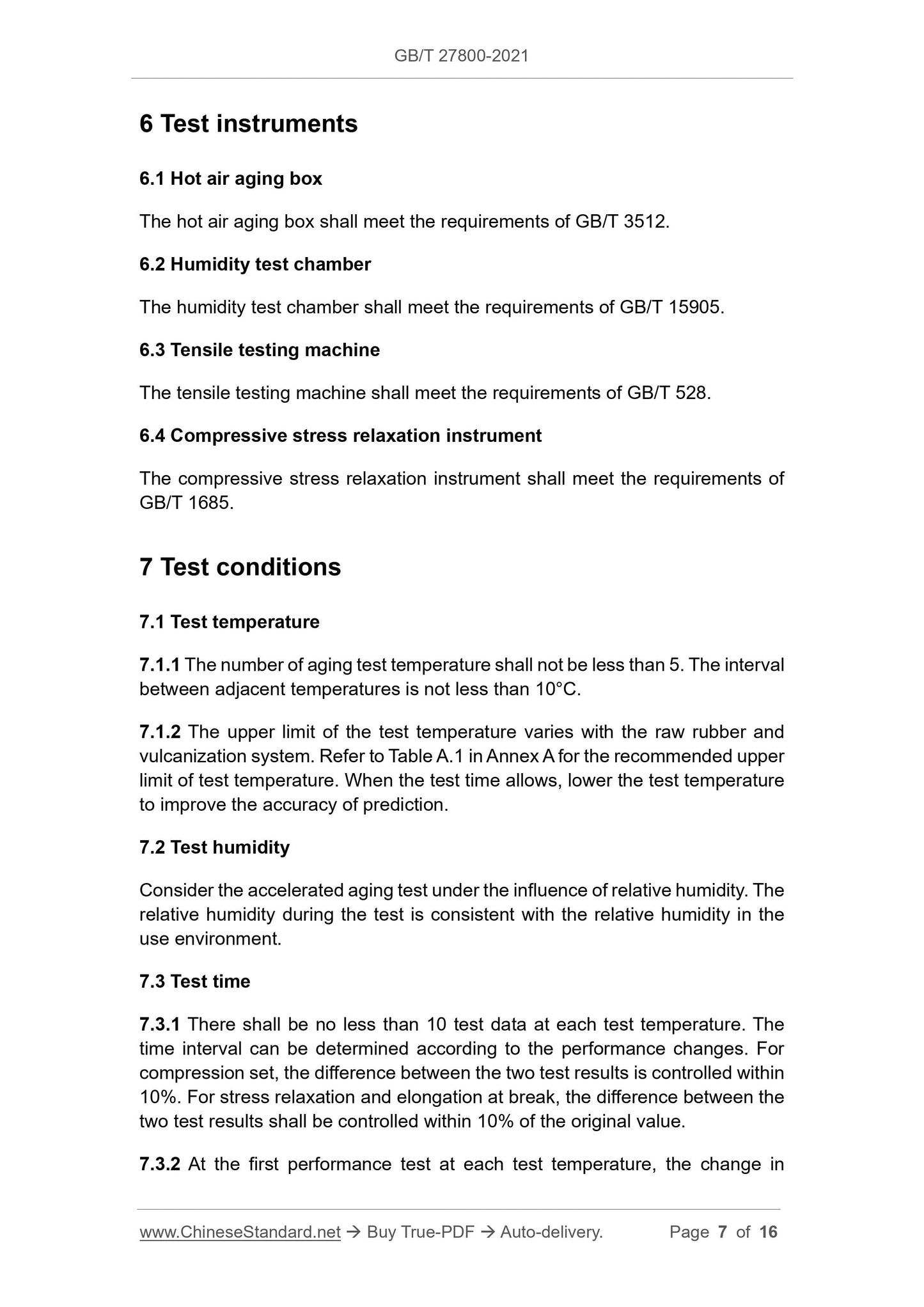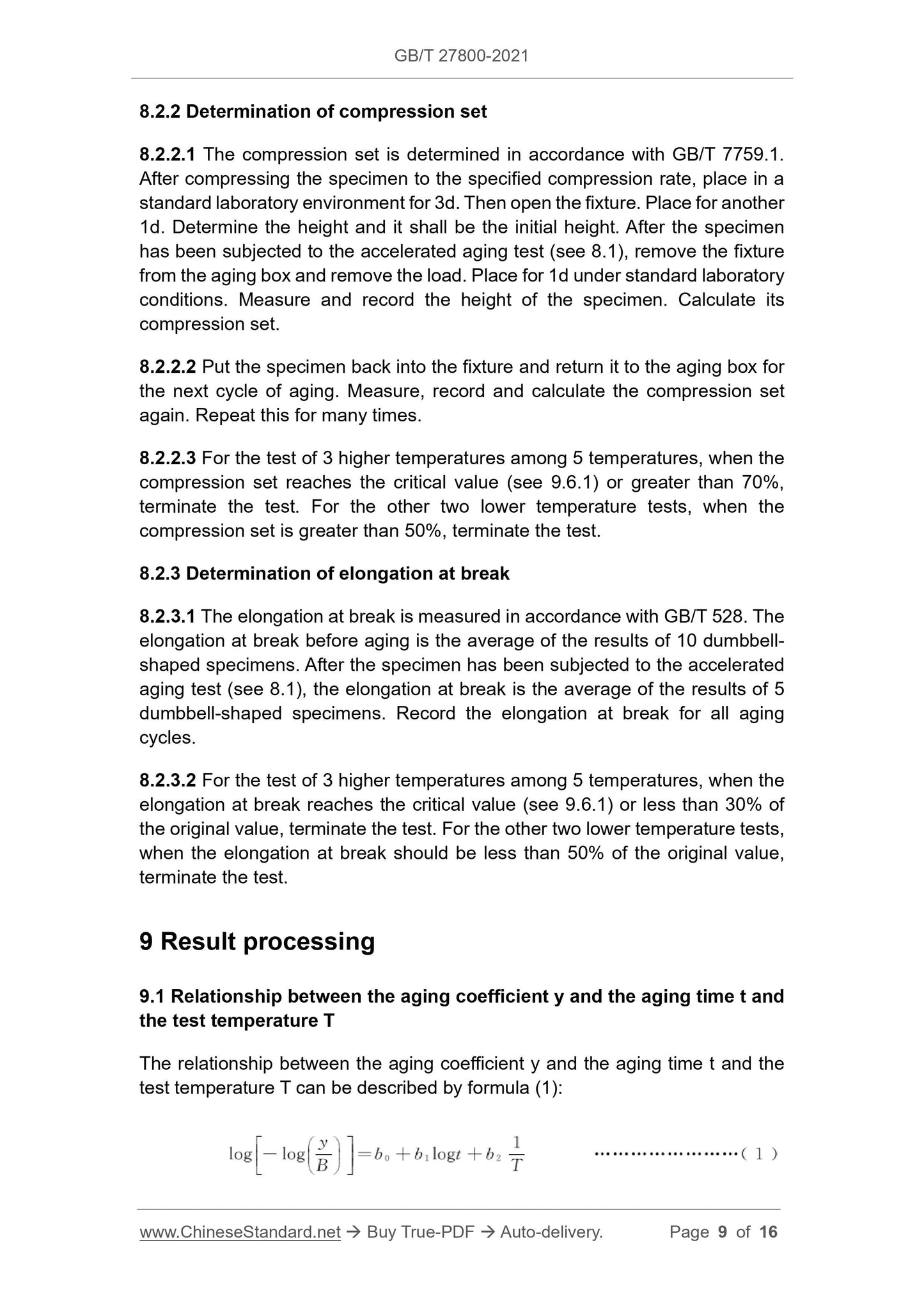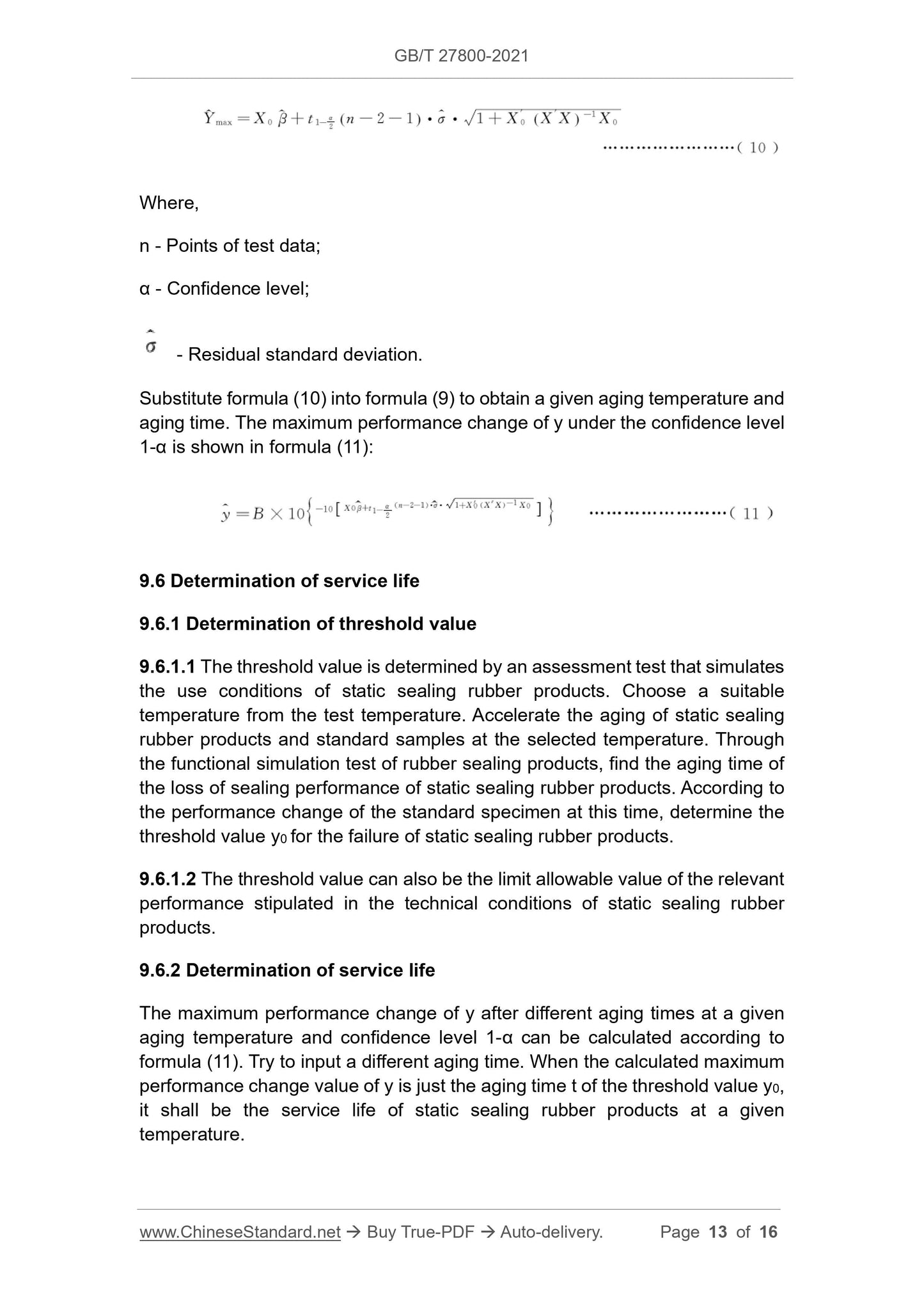1
/
of
6
PayPal, credit cards. Download editable-PDF and invoice in 1 second!
GB/T 27800-2021 English PDF (GBT27800-2021)
GB/T 27800-2021 English PDF (GBT27800-2021)
Regular price
$200.00 USD
Regular price
Sale price
$200.00 USD
Unit price
/
per
Shipping calculated at checkout.
Couldn't load pickup availability
Delivery: 3 seconds. Download true-PDF + Invoice.
Get QUOTATION in 1-minute: Click GB/T 27800-2021
Historical versions: GB/T 27800-2021
Preview True-PDF (Reload/Scroll if blank)
GB/T 27800-2021: Determination of the life for static sealing rubber products
GB/T 27800-2021
GB
NATIONAL STANDARD OF THE
PEOPLE’S REPUBLIC OF CHINA
ICS 83.140.50
CCS G 43
Replacing GB/T 27800-2011
Determination of the life for static sealing rubber
products
ISSUED ON: MAY 21, 2021
IMPLEMENTED ON: DECEMBER 01, 2021
Issued by: State Administration for Market Regulation;
Standardization Administration of the People's Republic of
China.
Table of Contents
Foreword ... 3
1 Scope ... 5
2 Normative references ... 5
3 Terms and definitions ... 6
4 Principle ... 6
5 Specimen ... 6
6 Test instruments ... 7
7 Test conditions ... 7
8 Test steps ... 8
9 Result processing ... 9
10 Test report ... 14
Annex A (informative) Suggestions on the upper limit of temperature for
accelerated aging test of different kinds of rubber materials ... 15
Annex B (informative) Derivation of the relationship between the aging
coefficient y and the aging time t and the test temperature T ... 16
Determination of the life for static sealing rubber
products
1 Scope
This Standard specifies the fast-forecasting method to determine the service
life of static sealing rubber products.
This Standard is applicable to determine the service life of static sealing rubber
products in the state of compression (radial compression is 12%-25%, axial
compression is 15%-40%) when in contact with various media and air. It is also
applicable to determine the storage period of rubber products in free state.
2 Normative references
The following referenced documents are indispensable for the application of
this document. For dated references, only the edition cited applies. For undated
references, the latest edition of the referenced document (including any
amendments) applies.
GB/T 528, Rubber, vulcanized or thermoplastic - Determination of tensile
stress-strain properties
GB/T 1683, Rubber, vulcanized - Determination of compression set at
constant strain
GB/T 1685, Rubber, vulcanized or thermoplastic - Determination of stress
relaxation in compression at ambient and at elevated temperatures
GB/T 1690, Rubber vulcanized or thermoplastic - Determination of the effect
of liquids
GB/T 3512, Rubber, vulcanized or thermoplastic - Accelerated ageing and
heat resistance tests - Air-oven method
GB/T 5720, Test methods for rubber O-rings
GB/T 7759.1, Rubber, vulcanized or thermoplastic - Determination of
compression set - Part 1: At ambient or elevated temperatures
GB/T 15905, Rubber, vulcanized - Test method of damp heat aging
6 Test instruments
6.1 Hot air aging box
The hot air aging box shall meet the requirements of GB/T 3512.
6.2 Humidity test chamber
The humidity test chamber shall meet the requirements of GB/T 15905.
6.3 Tensile testing machine
The tensile testing machine shall meet the requirements of GB/T 528.
6.4 Compressive stress relaxation instrument
The compressive stress relaxation instrument shall meet the requirements of
GB/T 1685.
7 Test conditions
7.1 Test temperature
7.1.1 The number of aging test temperature shall not be less than 5. The interval
between adjacent temperatures is not less than 10°C.
7.1.2 The upper limit of the test temperature varies with the raw rubber and
vulcanization system. Refer to Table A.1 in Annex A for the recommended upper
limit of test temperature. When the test time allows, lower the test temperature
to improve the accuracy of prediction.
7.2 Test humidity
Consider the accelerated aging test under the influence of relative humidity. The
relative humidity during the test is consistent with the relative humidity in the
use environment.
7.3 Test time
7.3.1 There shall be no less than 10 test data at each test temperature. The
time interval can be determined according to the performance changes. For
compression set, the difference between the two test results is controlled within
10%. For stress relaxation and elongation at break, the difference between the
two test results shall be controlled within 10% of the original value.
7.3.2 At the first performance test at each test temperature, the change in
8.2.2 Determination of compression set
8.2.2.1 The compression set is determined in accordance with GB/T 7759.1.
After compressing the specimen to the specified compression rate, place in a
standard laboratory environment for 3d. Then open the fixture. Place for another
1d. Determine the height and it shall be the initial height. After the specimen
has been subjected to the accelerated aging test (see 8.1), remove the fixture
from the aging box and remove the load. Place for 1d under standard laboratory
conditions. Measure and record the height of the specimen. Calculate its
compression set.
8.2.2.2 Put the specimen back into the fixture and return it to the aging box for
the next cycle of aging. Measure, record and calculate the compression set
again. Repeat this for many times.
8.2.2.3 For the test of 3 higher temperatures among 5 temperatures, when the
compression set reaches the critical value (see 9.6.1) or greater than 70%,
terminate the test. For the other two lower temperature tests, when the
compression set is greater than 50%, terminate the test.
8.2.3 Determination of elongation at break
8.2.3.1 The elongation at break is measured in accordance with GB/T 528. The
elongation at break before aging is the average of the results of 10 dumbbell-
shaped specimens. After the specimen has been subjected to the accelerated
aging test (see 8.1), the elongation at break is the average of the results of 5
dumbbell-shaped specimens. Record the elongation at break for all aging
cycles.
8.2.3.2 For the test of 3 higher temperatures among 5 temperatures, when the
elongation at break reaches the critical value (see 9.6.1) or less than 30% of
the original value, terminate the test. For the other two lower temperature tests,
when the elongation at break should be less than 50% of the original value,
terminate the test.
9 Result processing
9.1 Relationship between the aging coefficient y and the aging time t and
the test temperature T
The relationship between the aging coefficient y and the aging time t and the
test temperature T can be described by formula (1):
Where,
n - Points of test data;
α - Confidence level;
- Residual standard deviation.
Substitute formula (10) into formula (9) to obtain a given aging temperature and
aging time. The maximum performance change of y under the confidence level
1-α is shown in formula (11):
9.6 Determination of service life
9.6.1 Determination of threshold value
9.6.1.1 The threshold value is determined by an assessment test that simulates
the use conditions of static sealing rubber products. Choose a suitable
temperature from the test temperature. Accelerate the aging of static sealing
rubber products and standard samples at the selected temperature. Through
the functional simulation test of rubber sealing products, find the aging time of
the loss of sealing performance of static sealing rubber products. According to
the performance change of the standard specimen at this time, determine the
threshold value y0 for the failure of static sealing rubber products.
9.6.1.2 The threshold value can also be the limit allowable value of the relevant
performance stipulated in the technical conditions of static sealing rubber
products.
9.6.2 Determination of service life
The maximum performance change of y after different ag...
Get QUOTATION in 1-minute: Click GB/T 27800-2021
Historical versions: GB/T 27800-2021
Preview True-PDF (Reload/Scroll if blank)
GB/T 27800-2021: Determination of the life for static sealing rubber products
GB/T 27800-2021
GB
NATIONAL STANDARD OF THE
PEOPLE’S REPUBLIC OF CHINA
ICS 83.140.50
CCS G 43
Replacing GB/T 27800-2011
Determination of the life for static sealing rubber
products
ISSUED ON: MAY 21, 2021
IMPLEMENTED ON: DECEMBER 01, 2021
Issued by: State Administration for Market Regulation;
Standardization Administration of the People's Republic of
China.
Table of Contents
Foreword ... 3
1 Scope ... 5
2 Normative references ... 5
3 Terms and definitions ... 6
4 Principle ... 6
5 Specimen ... 6
6 Test instruments ... 7
7 Test conditions ... 7
8 Test steps ... 8
9 Result processing ... 9
10 Test report ... 14
Annex A (informative) Suggestions on the upper limit of temperature for
accelerated aging test of different kinds of rubber materials ... 15
Annex B (informative) Derivation of the relationship between the aging
coefficient y and the aging time t and the test temperature T ... 16
Determination of the life for static sealing rubber
products
1 Scope
This Standard specifies the fast-forecasting method to determine the service
life of static sealing rubber products.
This Standard is applicable to determine the service life of static sealing rubber
products in the state of compression (radial compression is 12%-25%, axial
compression is 15%-40%) when in contact with various media and air. It is also
applicable to determine the storage period of rubber products in free state.
2 Normative references
The following referenced documents are indispensable for the application of
this document. For dated references, only the edition cited applies. For undated
references, the latest edition of the referenced document (including any
amendments) applies.
GB/T 528, Rubber, vulcanized or thermoplastic - Determination of tensile
stress-strain properties
GB/T 1683, Rubber, vulcanized - Determination of compression set at
constant strain
GB/T 1685, Rubber, vulcanized or thermoplastic - Determination of stress
relaxation in compression at ambient and at elevated temperatures
GB/T 1690, Rubber vulcanized or thermoplastic - Determination of the effect
of liquids
GB/T 3512, Rubber, vulcanized or thermoplastic - Accelerated ageing and
heat resistance tests - Air-oven method
GB/T 5720, Test methods for rubber O-rings
GB/T 7759.1, Rubber, vulcanized or thermoplastic - Determination of
compression set - Part 1: At ambient or elevated temperatures
GB/T 15905, Rubber, vulcanized - Test method of damp heat aging
6 Test instruments
6.1 Hot air aging box
The hot air aging box shall meet the requirements of GB/T 3512.
6.2 Humidity test chamber
The humidity test chamber shall meet the requirements of GB/T 15905.
6.3 Tensile testing machine
The tensile testing machine shall meet the requirements of GB/T 528.
6.4 Compressive stress relaxation instrument
The compressive stress relaxation instrument shall meet the requirements of
GB/T 1685.
7 Test conditions
7.1 Test temperature
7.1.1 The number of aging test temperature shall not be less than 5. The interval
between adjacent temperatures is not less than 10°C.
7.1.2 The upper limit of the test temperature varies with the raw rubber and
vulcanization system. Refer to Table A.1 in Annex A for the recommended upper
limit of test temperature. When the test time allows, lower the test temperature
to improve the accuracy of prediction.
7.2 Test humidity
Consider the accelerated aging test under the influence of relative humidity. The
relative humidity during the test is consistent with the relative humidity in the
use environment.
7.3 Test time
7.3.1 There shall be no less than 10 test data at each test temperature. The
time interval can be determined according to the performance changes. For
compression set, the difference between the two test results is controlled within
10%. For stress relaxation and elongation at break, the difference between the
two test results shall be controlled within 10% of the original value.
7.3.2 At the first performance test at each test temperature, the change in
8.2.2 Determination of compression set
8.2.2.1 The compression set is determined in accordance with GB/T 7759.1.
After compressing the specimen to the specified compression rate, place in a
standard laboratory environment for 3d. Then open the fixture. Place for another
1d. Determine the height and it shall be the initial height. After the specimen
has been subjected to the accelerated aging test (see 8.1), remove the fixture
from the aging box and remove the load. Place for 1d under standard laboratory
conditions. Measure and record the height of the specimen. Calculate its
compression set.
8.2.2.2 Put the specimen back into the fixture and return it to the aging box for
the next cycle of aging. Measure, record and calculate the compression set
again. Repeat this for many times.
8.2.2.3 For the test of 3 higher temperatures among 5 temperatures, when the
compression set reaches the critical value (see 9.6.1) or greater than 70%,
terminate the test. For the other two lower temperature tests, when the
compression set is greater than 50%, terminate the test.
8.2.3 Determination of elongation at break
8.2.3.1 The elongation at break is measured in accordance with GB/T 528. The
elongation at break before aging is the average of the results of 10 dumbbell-
shaped specimens. After the specimen has been subjected to the accelerated
aging test (see 8.1), the elongation at break is the average of the results of 5
dumbbell-shaped specimens. Record the elongation at break for all aging
cycles.
8.2.3.2 For the test of 3 higher temperatures among 5 temperatures, when the
elongation at break reaches the critical value (see 9.6.1) or less than 30% of
the original value, terminate the test. For the other two lower temperature tests,
when the elongation at break should be less than 50% of the original value,
terminate the test.
9 Result processing
9.1 Relationship between the aging coefficient y and the aging time t and
the test temperature T
The relationship between the aging coefficient y and the aging time t and the
test temperature T can be described by formula (1):
Where,
n - Points of test data;
α - Confidence level;
- Residual standard deviation.
Substitute formula (10) into formula (9) to obtain a given aging temperature and
aging time. The maximum performance change of y under the confidence level
1-α is shown in formula (11):
9.6 Determination of service life
9.6.1 Determination of threshold value
9.6.1.1 The threshold value is determined by an assessment test that simulates
the use conditions of static sealing rubber products. Choose a suitable
temperature from the test temperature. Accelerate the aging of static sealing
rubber products and standard samples at the selected temperature. Through
the functional simulation test of rubber sealing products, find the aging time of
the loss of sealing performance of static sealing rubber products. According to
the performance change of the standard specimen at this time, determine the
threshold value y0 for the failure of static sealing rubber products.
9.6.1.2 The threshold value can also be the limit allowable value of the relevant
performance stipulated in the technical conditions of static sealing rubber
products.
9.6.2 Determination of service life
The maximum performance change of y after different ag...
Share
